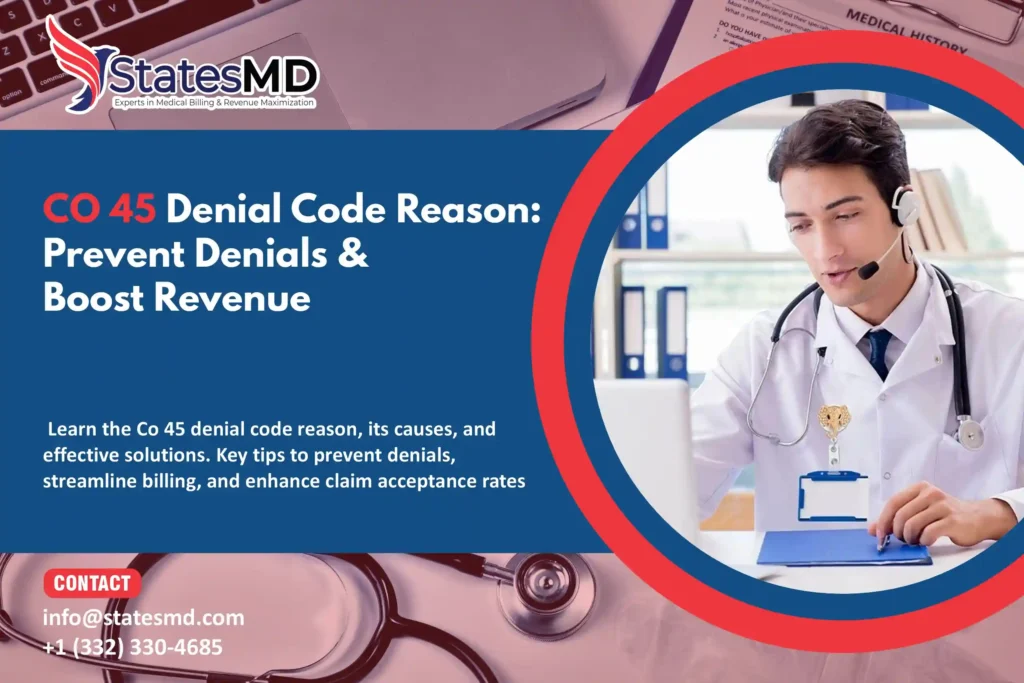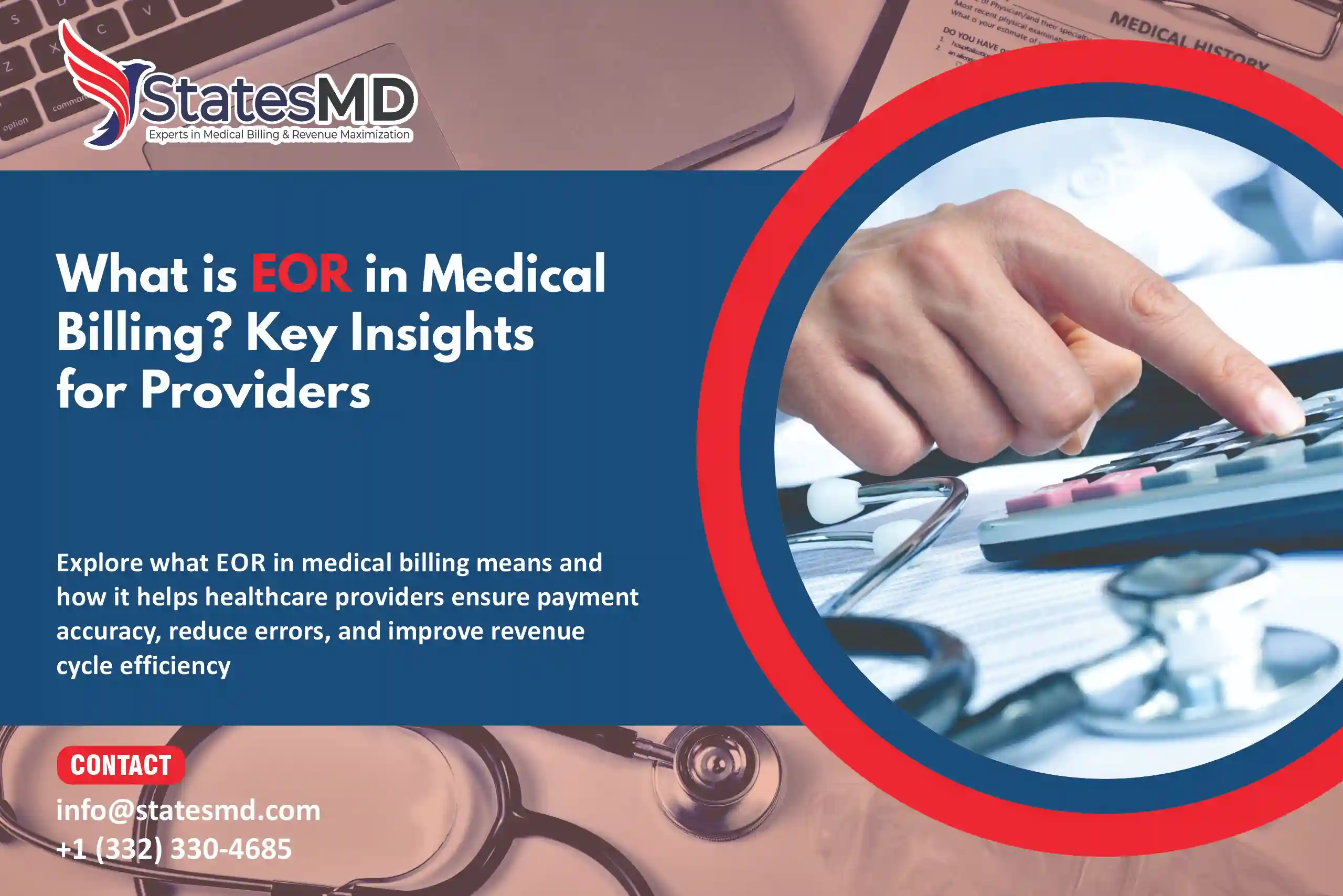Have you ever been confused about why your claims are repeatedly refused, even if you think everything is in order? One of the most common reasons is the Co 45 denial code, which shows charges that exceed the payer’s allowable amounts. Denials like these can severely delay reimbursements and affect your revenue cycle. 10-15% of all medical claims are refused, with 30% denials due to insufficient billing practices such as misplaced costs and out-of-date price schedules.
Knowing and handling this code is crucial for healthcare providers, medical billers, and revenue cycle specialists as it reduces administrative costs and improves cash flow. Correcting these issues will boost your claim success rates and prevent revenue loss. Studies indicate that dealing with denial concerns such as Co 45 can result in an average revenue profit of 5-10% for healthcare institutions.
More About To Know the Co 45 Denial code
Co 45 denial code is a claim adjustment reason code suggesting the billed cost indicates the cost billed exceeds the payer’s acceptable limit. This rejection occurs when the reported charges differ from the amounts permitted by the payer’s fee schedule, contracted rates, or maximum allowable charges. Healthcare providers and medical billers often face this issue, which results in delayed reimbursements and additional administrative challenges.
This denial can be caused by various situations, including inaccurate coding, out-of-date charge schedules, or a failure to follow the required contractual terms. For example, if a provider submits costs that exceed the payer’s set rate, the payer will change the claim and assign the There is a difference between the Co 45 refusal code and the rejection code. Understanding this rejection is critical for correcting payment problems and ensuring constant cash flow.
Healthcare workers can increase claim acceptance rates and decrease revenue cycle inefficiencies by recognizing and addressing the underlying reasons for the denials. Regular contract reviews, coding correctness, and price schedules are the most important steps in properly handling this issue.
Common Causes of the Co 45 Denial Code
Understanding the causes of the rejection code issues is crucial for healthcare providers and billing professionals. Denials are frequently the result of disparities between reported costs and payer expectations.
Overcharging Beyond the Payer Fee Schedules
When providers charge amounts that exceed the payer’s authorized fees, the excess is adjusted using this denial code. Payers establish limitations based on contractual agreements or regular price schedules. Submitting charges that exceed these restrictions causes an adjustment, which results in a refusal.
- For example, if a payer authorizes $150 for a procedure but the claim shows $200, the $50 discrepancy is applied to the Co 45 refusal.
Outdated Fee Schedules
Fee schedules that are not consistently updated to reflect payer revisions can result in denials. Providers who charge using outdated rates risk having their claims scrutinized for irregularities.
- Preventive Measure: Review and update charge schedules in billing software to ensure payer agreement compliance.
Non-compliance with contractual agreements
Payer contracts include particular provisions such as agreed service prices. Failure to keep to these agreements, such as utilizing inaccurate codes or invoicing for non-covered treatments, frequently results in Co 45 refusal codes.
- Solution: Conduct regular audits to ensure claims comply with payer contracts and rules.
Duplicate adjustments or claims
Submitting duplicate claims or revisions for the same service may result in denials under Co 45. This is generally due to human error or a lack of claim tracking.
- Tip: Use strong claim tracking systems and teach employees to avoid duplicate submissions.
Steps to Resolve Co 45 Denial Code
Addressing these rejection codes efficiently is critical for maintaining a healthy revenue cycle. Each component of the resolution process is designed to identify problems, verify compliance, and ensure compliance.
Step 1: Review the Denial and Fee Schedule
Use payer portals or resources to compare currently permitted amounts.
- Check the explanation of benefits (EOB) or remittance advice (RA) to ensure the denial is due to Co 45 denial code grounds.
- Compare the billed amount to the payer’s authorized amount as shown on the charge schedule.
- Check the claim for outdated charge schedules or erroneous codes.
Step 2: Update and Align Fee Schedules
Conduct quarterly fee schedule reviews to keep up with payer updates
- Identify any differences between your billing rates and the payer’s charge schedule.
- Update your practice management system or billing software to include the most recent charge schedules.
- To avoid future denials, ensure your employees consistently apply the new rates.
Step 3: Ensure Contractual Compliance
Make a checklist for claim submissions to guarantee compliance with payer contracts.
- Check that the billed charges meet the terms mentioned in your payer contracts.
- Evaluate whether the denial was due to non-covered services or inaccurate modifiers.
- Discuss any doubts about payer agreements with your staff.
Step 4: Resubmit Corrected Claims or Appeal
Payers frequently set specific timelines for appeals. Meet deadlines to avoid claim rejection.
- For valid charges, submit revised claims that include the relevant fee schedule or code modifications.
- If the denial was wrong, file a well-documented appeal with supporting information, such as payer rules or contract conditions.
- Check the status of your appeal and follow up if required.
How to Avoid Co 45 Denials
Efficient denial prevention solutions are crucial for ensuring a smooth revenue cycle and lowering administrative costs. The following strategies can help healthcare professionals avoid denials.
Regular Fee Schedule Updates
Keep fee schedules updated to align with payer policies and prevent overbilling.
- Ensure your billing system is current with the newest payer fee schedules.
- To avoid overbilling, review internal charge schedules with payers regularly.
- Schedule regular assessments to maintain constant alignment with changes in payer policies.
Billing Staff Training
Provide ongoing training to billing staff on coding accuracy and payer-specific rules.
- Train billing staff to understand payer-specific restrictions and the value of proper coding.
- Provide regular workshops on fee schedule modifications, modifier usage, and claim submissions.
- Provide continuing education on contractual agreements and reimbursement policies.
Technology Integration
Use automatic billing technologies to reduce errors and ensure timely updates.
- Use automatic invoicing software to decrease human error in claim submission.
- Implement technologies that provide real-time updates to payer fee schedules and eligibility checks.
- Use reporting tools to monitor and respond to rejection trends quickly.
Eligibility and Policy Verification
Verify patient eligibility and policy details before submitting claims to avoid denials.
- Before submitting claims, confirm patient eligibility and coverage details.
- Check for any policy-specific constraints that could result in refusal.
- Maintain accurate records of payer agreements and update them regularly for convenient reference.
Conclusion
Addressing Co 45 rejection code issues is critical to sustaining a healthy revenue cycle. Healthcare providers can reduce claim denials by analyzing the causes and implementing preventive actions such as modifying charge schedules, training billing workers, and employing technology. Accurate eligibility verification and attention to payer agreements improve claim acceptance rates. Consistent process improvements and quick follow-ups could cut administrative costs while increasing cash flow.
FAQs
1. What does the CO 45 denial code mean?
The CO 45 denial code indicates that the charges billed exceed the payer’s allowable amount as per their fee schedule or contractual limits.
2. What causes the CO 45 denial code?
Common causes include outdated fee schedules, incorrect coding, exceeding payer rates, or non-compliance with contractual agreements.
3. How can healthcare providers prevent CO 45 denials?
Regularly updating fee schedules, training billing staff, and verifying patient eligibility can help reduce CO 45 denials.
4. What steps should I take to resolve a CO 45 denial?
Review the denial reason, align fee schedules, ensure contractual compliance, and resubmit corrected claims or file an appeal with supporting documentation.
5. Why is addressing CO 45 denials important for revenue cycle management?
Handling CO 45 denials ensures timely reimbursements, reduces administrative costs and maintains steady cash flow for healthcare providers.




